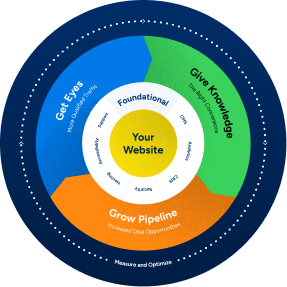As all experienced marketers know, people rarely make instant buying decisions. Unless the cost is inconsequential, or the person is incredibly impulsive, they aren’t going to purchase a product or service immediately after hearing about it. They’ll need some time to think about the costs and benefits, evaluate their options, and finally part with their money or move along.
Even if you didn’t know anything about e-commerce or online lead generation, you would be familiar with this process. That’s because you undoubtedly follow it yourself when making any buying decision. Whether you’re getting an electric toothbrush or a new car you probably spend a little bit of time (or maybe a lot) making sure you won’t be wasting your hard-earned cash.
Knowing this, why do so many business owners and executives develop content that completely ignores the reality of decision making? Why do they write articles and pages that assume prospects will see them and make an instant decision?
In many cases, it could be that they are simply following the examples of what they’ve seen other marketers do (even though they might not have any idea about the results generated). In other situations they might not have given the issue much thought at all. Whatever the cause, ignoring the needs that potential customers or clients have in order to gather information in a predictable way hurts conversions. We can do better.
This post is going to help you avoid the same kinds of mistakes. Let’s look at what you need to know to make your content fit the buyer’s journey in a way that leads to real and measurable sales results.
How Do Humans Make Buying Decisions?
If the bad news is that you can’t ignore the decision process, then the good news is that we all tend to follow it in a very similar way again and again. In other words, if you understand the steps – known in the marketing industry as the buyer’s journey – then you can use it to your benefit.
Broadly speaking, the buyer’s journey can be broken into three parts:
Awareness – in this step of the journey, a potential customer becomes aware of your product or service. This could be because they have a problem that they need assistance with, or because they come across your marketing. In this context, the “marketing” your company does could even include online reviews, word-of-mouth referrals, or branding activities, along with traditional ads, content marketing, and sales calls.
In the awareness stage a buyer knows what you have, but they probably don’t have much additional information. They are unlikely to know what makes your business, products, or services special. They may be curious about the cost and wonder how you stack up to the competition. In order for them to move past this stage in the buying process they need to do some research.
Consideration – the consideration stage is all about filling in the knowledge gaps that exist after awareness. This is a step you probably know well as a customer. It involves looking at features, checking out reviews, and looking for comparisons.
One interesting detail about the consideration buying stage is that buyers will usually get their information from sources that are trusted and convenient. Also, they want perspectives that apply to their situation and needs. For example, someone who needs cookware for their home will probably use different resources than the buyer for a string of franchise restaurants. That’s because their budgets, concerns, and decision criteria are much different.
Decision – the decision stage is just what it sounds like. Eventually, after they have the information they need, a buyer will decide to go with your solution, a competitor’s solution, or not at all. This decision will obviously be influenced by factors around price, but it’s important not to underestimate the role emotions play at this stage.
Obviously, some people are drawn to certain brands and marketing messages. For the most part, though, they develop a level of psychological comfort with a certain product or service while they are researching and start to feel safer and safer with that option. So, if they spend most of their time researching answers on your website it’s quite likely that they’ll end up buying from you.
The buyer’s journey can move quickly or slowly. The deciding factor is usually the consequences involved. Most of us will spend a second or two selecting a candy bar, but might wait months or years before making an offer on a new house. A home costs a lot more and affects our lives in a deeper way so it’s the kind of decision we want to get right.
Mapping Content to Buyer Behavior
Once you understand the buyer’s journey and why your customers will almost always follow it, the process of creating content for your website gets a lot easier. The sales funnels that marketing gurus are always talking about suddenly make sense.
At the top of your sales funnel are those potential buyers in the awareness stage (or maybe those waiting to be moved into the awareness stage). You can reach them with ads, social outreach, and search-optimized articles that shed light into the problems or challenges that you can help them solve. It’s all about helping people who know nothing about your company and its products or services, to realize that you exist and can make their lives easier.
The content you produce for those in the consideration stage should be more in-depth and informative. You could produce longer articles, how-to and comparison videos, or white papers that show off the successes other buyers have had. Each of these should aim to give the people you want to sell to more information than they had before, and to do it in a way that seems like it’s directed straight to them. Use the language they would, address their biggest concerns, and avoid jargon or concepts that are over their heads.
Finally, you can encourage buyers to make decisions by giving them irresistible offers. Something like a one-time discount code or a free coaching session can help remove the sense of risk in their minds and nudge them in your direction. So too can trust indicators like money-back guarantees and positive reviews from existing customers.
The Art of Automation
Understanding the buyer’s journey and how to use it within your content strategy gives you a powerful advantage over the competition. However, it’s when you take the next step and start to automate that content delivery, that your business is transformed.
Imagine for a moment that you were constantly producing articles, ads, videos, and social posts that were reaching your target audience of prospects every day. More and more people would become aware of you and your products and services. At any given time, a certain percentage of them might be willing to share their contact details (like an email address) to get more information from you. They would be moving from the awareness stage to the consideration stage.
At that point you could have email auto responders and other tools set up to deliver consideration-focused content to them at regular intervals. They can opt-in to receive emails, reports, product reviews, buying guides, or other resources. These would be geared towards buyers just like them in a specific category.
With all of that content moving automatically, some wonderful things happen. First, the lead is nurtured in a way that takes no time or effort on your part. Second, and more importantly, that contact becomes more and more likely to do business with you once they are ready. If at some point, their buyer’s journey ends, they can decide to stop hearing from you. Otherwise, they’ll keep getting information and updates that draw them closer and closer to your company.
As time goes on, your automated sales funnel can encourage a decision with the kinds of offers we’ve already described. Your prospect can keep thinking about their options, make a decision, or stop getting the content if they determine you can’t help them. That means at the end of the automated process you either get a very qualified lead or a potential future customer who didn’t waste any of your time while they researched.
When you use knowledge of the buyer’s journey, smart content strategy, and targeted automation tools together, amazing things can happen.
Need Help Turning Your Website Into a Lead Generation Machine?
Do you feel like your business website and online marketing strategy were painted by numbers? Do you have the basics, but not a comprehensive plan that helps you attract buyers, engage them online, and then turn them into qualified leads or sales? If so, we can help.
At GoingClear, we don’t just design and develop great-looking websites and social media campaigns – we help our clients to make real bottom-line improvement. Contact us today to schedule a free consultation. There’s no obligation to work with us after that, but we might be able to generate some ideas that permanently change your company’s future.

